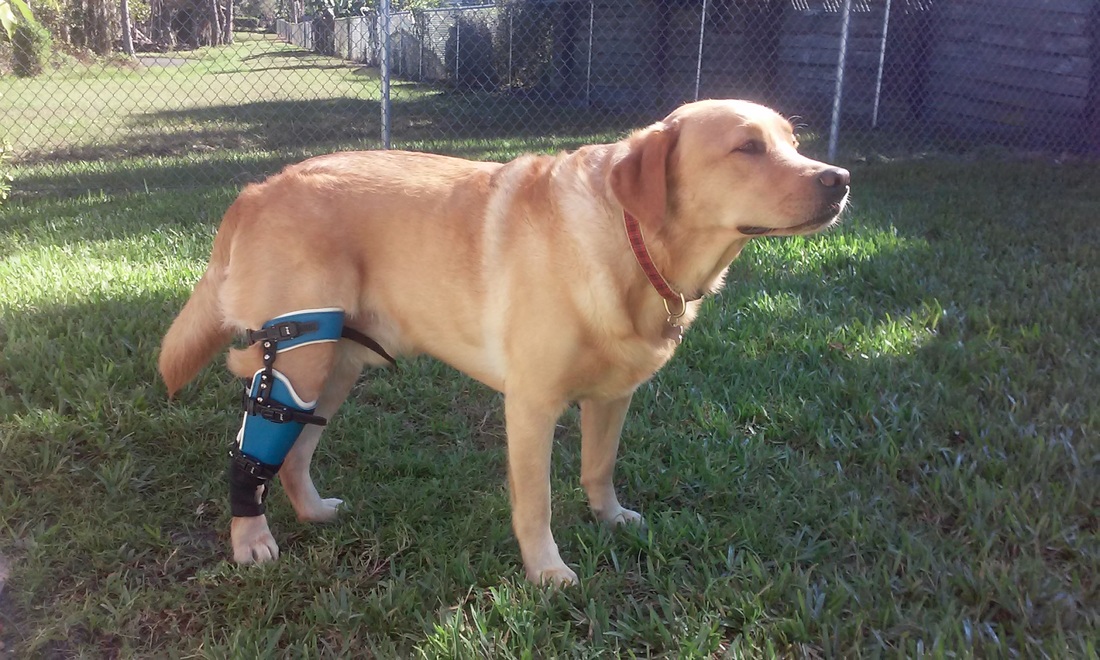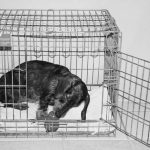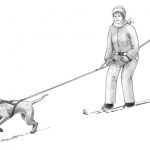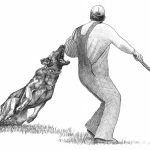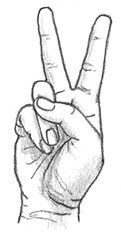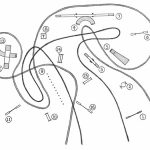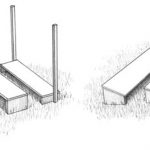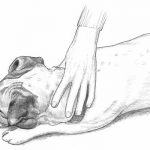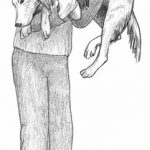- Keeping your dog hydrated and rested
- Treating bone and soft-tissue injuries
- Treating shock
Tricks, agility classes, and breed-specific activities are great ways to channel your dog’s energy and passions. If you’re like most people, you don’t think much about injuries when you’re starting out on a new adventure. You think about fun and excitement, not ice packs and aspirin. But accidents and injuries can and do happen, especially if your dog is overweight, underconditioned, or not given enough of a warm-up. This chapter describes common sports injuries that can happen to any dog.
Tip
If your dog does have an accident during a workout, stay cool. If you lose it, he’ll get nervous and go to pieces. Be a rock of confidence. Be mentally tough. Organize. Think. If necessary, get him to the veterinarian as quickly and as carefully as possible.
Dehydration
Dehydration signals more than excessive thirst; it signals an excessive loss of body fluids. If you sense your dog is way off and looking hollow, test for dehydration by pinching the skin on his back. If it remains rigid and does not fall back into place, he’s dehydrated. Give him room-temperature water in small half-cup doses to prevent vomiting and go to an animal hospital immediately.
Warning!
Fever accelerates dehydration; so does vomiting and diarrhea. A dog must drink enough water to offset the fluids lost during activity and prolonged heat exposure. If your dog is panting, give him water — and give it to him often.
Fatigue
Sometimes even dogs get dog-tired. Unable to focus and perform, they need some quick R & R to rebalance. That said, your dog will often let on that he doesn’t need a break; he may actually push himself to the point of exhaustion or, worse, injury. Signs of fatigue include the following:
- Stumbling or refusing obstacles
- Gait inconsistency
- Inability to focus
- Distractibility
If your dog seems out of sorts, stop and check him out head to tail. If he appears fine, take a water break, chill out, or go for a quiet walk. Dogs have off days too, and although certain spaciness is understandable, your dog’s inconsistencies could signal illness or potential injury. If a short walk doesn’t improve your dog’s mood, quit for the day and watch your dog’s behavior, body cues, and functions. How’s his mood? Too much pressure to perform can affect your dog’s mental state like a kid who must practice instead of play. Is he eating and drinking normally? Are his stools normal? If not, make an appointment to see his veterinarian.
Fever
Dogs, like people, get fevers. In simple terms, a fever represents that a dog’s internal system is in overdrive, like water brought to a boil. When a dog gets hot or is agitated or athletically pumped, the cells inside his body rev up and voilà — a fever!
Tip
Though dogs’ normal temperature is a lot higher than humans’ (101 to 102 degrees on average), it fluctuates more rapidly, too. A spike of 1 or 2 degrees in either direction is considered normal. Take your dog’s temperature on a good day, noting the healthy readings, so that you can compare.
What brings a fever down? Anything that will cool their insides. A refreshing drink, air conditioning or shade, or a cool shower — or if your dog is seriously overheated, ice packs on his head or thighs.
Warning!
A prolonged fever or heatstroke signals something more serious and warrants the immediate attention of a veterinarian. If you can’t get your dog’s temperature to go down or stay down, of if your dog is panting heavily and has a dazed expression, give him a cool shower and call the vet right away.
Back and Neck Injury
Dogs are marvelous animals of movement. Watching an agility dog navigate and twist through and around obstacles is a wonder indeed. Lure coursing, sledding, athletic trials, and other persuasions require that your dog be in top physical condition and that he be warmed up before each event or outing.
The finely tuned musculoskeletal system makes all this motion possible, and when it’s working well, your dog’s movement looks effortless. A slight injury may only cause a ripple in his motion; however, acute neck or back pain causes the house of cards to fall. Dogs suffering spinal injuries can’t move well, if at all.
Tip
If you suspect your dog is suffering from back or neck pain, stop everything and see your veterinarian immediately. Best case scenario, a slight bulge in one of your dog’s discs is putting pressure on a nerve; time and rest will heal the spasms, though you’ll need to be mindful because your dog will be prone to re-injury. Worst case, a disc has slipped or degenerated and is tweaking the surrounding nerves. In this case, your dog’s athletic career is over, and he may need surgical intervention.
Symptoms of a back or neck injury include the following:
- Limping, weakness, or paralysis
- Diarrhea or bloody vomiting
- Abdominal pain, often noted in a distended belly
- Loss of bladder control
- Breathing difficulties
- Fever
- Strained neck movement
- Crying when attempting to walk
If you suspect neck or back injury, take every precaution and get your dog to a veterinarian immediately.
Tip
Transporting an injured dogTransporting a dog who has internal injuries is tricky business. He’ll be restless and want to move, and your job is to make sure he doesn’t. It’s best to have someone help you — the other person can drive, and you can comfort and restrain your dog. If transportation help isn’t available, however, don’t delay in getting your dog to the vet. Try to have someone call ahead so that the hospital is prepared to help upon your arrival. If you suspect a broken bone, a spinal injury, or internal bleeding, transport your dog on a firm surface such as metal or plywood. Place a blanket over the dog, but don’t cover his face because doing so may frighten him. Muzzle your dog for safety either with a professional cover or by using a belt or scarf wrapped over the nose and secured behind his ears. |
Broken Bones
A sudden impact, fall, or a twist while a dog is overexerted can result in a fracture. A broken bone is hard to ignore, even for a dog. Serious compound fractures, in which the bone is protruding through the skin, are obvious, and without prompt attention, they can cause severe damage and dramatic blood loss.
Tip
Although some dogs may attempt to limp through their pain, leash the dog immediately after an accident, fall, or sudden impact. A quick hand examination may reveal the sound or feeling of bone rubbing on bone, or you may need an X-ray to reveal a fracture.
If you suspect a fracture, restrain your dog as listed in the neck and back pain section of this chapter. Apply ice packs to decrease the swelling. If the fracture is in a limb, splint your dog’s leg above and below the area. Surround the area using a magazine or piece of cardboard and secure it in place with bandage tape. If you suspect the injury is in the spine, immobilize your dog as much as possible and transport him on a stretcher-like surface.
Foot Injury
I love going barefoot, feeling the dirt in my garden or the sand beneath my feet. That said, it’s hard to imagine hot doggin’ it 24/7, but that’s just what dogs do. Though some hard-core canine athletes wear booties when they run, most dogs arrive at each new adventure with their paws uncovered and at least initially unscathed.
Technical Stuff
Dogs’ paws do have some natural padding. Thickened keratinous foot pads (covered with the same substance that makes your fingernails tough) cushion and protect a dog’s paws, while intricate nerves act like a computer messaging system, helping the dog recognize and orient to each new terrain.
The more active a dog is, the more susceptible to injury he’ll be. Many things can cause injury, including
- Bee stings
- Cuts from glass, ice, or rough terrain
- Cracks from severe weather conditions or dry, rough footing
- Burns from excessively hot surfaces
In addition, a dog’s toenails, if not clipped, can inhibit his gait, leading to injuries such as a toe dislocation or split nail, an open wound that’s painful and open to infection. Many dogs still have a dew claw, a fifth claw located 1 to 3 inches up on their legs, that can get caught unpredictably and lead to painful tissue tearing.
Any one of these conditions can lead to localized swelling, limping, and/or infection if the open wound isn’t treated. Be aware of the signs and symptoms of foot injury. A dog suffering paw injury will favor the entire limb, lick the wound, or bite at his pads to remove a foreign body.
A quick look-see often reveals the underlying cause of foot pain, but a veterinarian’s attention will confirm the cause. It is important to have a veterinarian wash and disinfect open wounds and stabilize any limb that suffers tissue damage or bone breaks.
Tip
To prevent foot injuries, exercise your dog on a variety of surfaces, including grass, pavement (in cool temperatures to prevent pad burns), and sand, pebbles, or rocks to strengthen his pads, and keep your dog’s nails clipped monthly.
Strains and Sprains
Strains and sprains result when muscles are overused, pushed past their endurance point, or strained by twitching or wrenching. When working with your dog, set your expectation to what he can tolerate and be mindful that like people, dogs must warm up gradually and have plenty of water to keep fit. To warm up your dog, walk him at a steady pace for 1⁄4 to 1⁄2 mile or toss a ball to him in the yard for 5 to 10 minutes. You’re giving his muscles a gentle wake-up call!
Table 21-1 names four common soft-tissue injuries that cause limping and subtle changes in your dog’s gait.
Table 21-1 Soft-Tissue Injuries
|
Injury | Description/Symptoms | Treatment |
Sprains | A sprain is a stretching or laceration of the ligaments, which connect bones. Your dog will experience pain over the joint, swelling, lameness, and/or a decreased enthusiasm for activity. | The best cure? Rest and more rest. Ice placed over the area for 20 minutes an hour for the first three hours will help. |
Tendonitis | Tendonitis is inflammation of the tendon caused by overuse or an accident that involved twisting or wrenching. Movement will be painful and strained. | Rest is the sure cure; a splint may be necessary to stabilize the leg. |
Bruises | High-performance dogs can launch into an obstacle at top speed or crash into another dog and suffer a bruise in the same way people do. All a bruise is a sign of bleeding under the skin. | If the bruising is extreme, place a cold pack over the area to stop the bleeding and swelling. If your dog will allow it, keep the pack on for 10 minutes, wrapping the pack into place. |
Muscle strains | A muscle strain comes from an injured or torn muscle and can result from overexertion, a sudden stretch, or an impact to the muscle. Muscles often knot or spasm when injured. | Rest and cold packs will help ease the tenderness. Ice your dog’s injury as long as the injury is warm to the touch. Consider wrapping an ice pack over the injury for about 10 minutes. |
Tip
Your job is to find out what’s causing your dog to limp and which body part is in trouble. To figure out just where the pain is centralized, follow these steps:
1. Observe your dog when he’s standing still.
He’ll lean away from the hurt leg and put pressure on his stronger side. For example, if he hurt his right front leg, he’ll lean to the left and put weight onto the two back and the front left legs.
2. Watch him walk.
He’ll take a shorter step on his injured leg. His head also may bob up and down to compensate for the pressure he’s trying to keep off his injured limb.
3. To pinpoint the specific injury site, carefully rub your hands along your dog’s joints and note any muscle tenderness.
If you’re still puzzled, gently flex and rotate your dog’s joints. If he winces, whimpers, or moves from you, guess what — he’s hurting!
4. Look for discoloration and swelling.
5. Take your dog’s temperature.
Digital thermometers for dogs are now available, and they’re safer than traditional mercury ones. They can be inserted in the mouth, ear, or rectally for a most accurate reading (oh joy!). The normal range for a dog’s temperature is 101 to 102 degrees. (I know you want to put this book down this very minute and take your dog’s temperature!)
Remember that the quicker you or your vet diagnoses an injury, the easier the sprain or strain is to treat and the less likely it is that your dog will need surgery.
Torn Ligaments
Ligaments are swaths of tissue that connect the bones of a joint and give it stability during movement. Ligaments can get partially torn (causing a sprain) or completely torn. Tearing is a common injury, especially for athletic or heavily set, large-breed dogs — and it’s even more common when dogs are overweight.
The most common injury point for a torn ligament is in a dog’s knee: what is in humans called the anterior cruciate ligament, or ACL. (Note: It’s actually called a cranial or caudal cruciate ligament in dogs, but to keep it simple, many veterinarians use the human term).
Ligaments generally come in pairs, crisscrossing over a joint to stabilize it and prevent forward-backward mobility. When a ligament tears, the bones are displaced, the knee becomes unstable, and the bones often rub against each other. Ouch!
If a ligament is stretched or torn, you’ll need to give your dog a few weeks to months to fully recover. If you push your dog, he’ll be likely to suffer a more dramatic injury, as his enthusiasm will far exceed his physical capacities. If a ligament is left untreated, a dog can develop arthritis in the joint and will also place extra weight on the healthy leg, which often puts unbearable strain on those ligaments, resulting in a double whammy.
If your dog is lame and your veterinarian suspects a torn ligament, he’ll likely prescribe painkillers and suggest a period for recovery. If your dog is not bearing weight on a leg, a quick manipulating of the area may reveal what’s commonly known as the drawer movement: the unhinged bones can be easily maneuvered back and forth.
Shock
A dog can go into shock if he experiences a sudden loss of blood, a trauma, or electric shock. Shock is life-threatening if not treated promptly; it causes blood pressure to drop dramatically, which prevents oxygen from circulating in the body. Without oxygen, the body dies.
A dog in shock shows the following symptoms:
– A fast heart rate, as the heart tries to make up for a drop in blood pressure
– Rapid breathing, because the body is trying to increase oxygen flow
– Dilated pupils and a glaring stare
– Unconscious or semiconscious behavior
Warning!
Dogs in shock must see a veterinarian. If you suspect your dog has gone into shock, stay calm, keep him still, and get to the nearest veterinarian immediately. Have someone call the animal hospital so that the vet staff will be prepared to help upon your arrival.
by Sarah Hodgson
